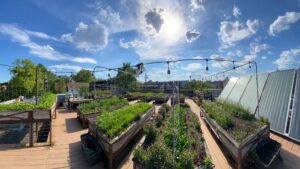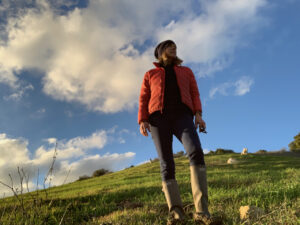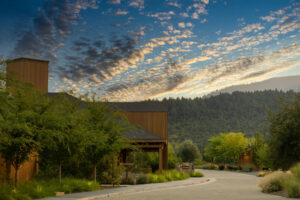
Uncommon Ground — America’s First Certified Organic Rooftop Farm
Founded by Helen and Mike Cameron, Uncommon Ground is America’s first certified organic rooftop farm.
USA
Seunghyun Natalia Woo May 10, 2021
Honoring California’s Rhone wine movement pioneered by his father, Jason Haas is the Partner and General Manager who manages the day-to-day operations and biodynamic practices at Tablas Creek Vineyard. Since running the 120-acre organic estate from the mid-2000s, Jason Haas was voted as the 2015 Paso Robles Wine Country Wine Industry Person of the Year and 2017 San Luis Obispo County Wine Industry Person of the Year.
Founded in 1989, Tablas Creek Vineyard was established by two renowned leaders of the international wine community: the Haas family of Vineyard Brands and Perrin family of Chateau de Beaucastel. Located in the western Adelaida wine district of Paso Robles, California, Tablas Creek has been an avid proponent of regenerative organic agricultural practices. In 2020, they became the first winery to secure the Regenerative Organic Certified title with its carbon farming and soil fertility practices. Complementary to their environmentally conscious practices, Tablas Creek continues to lead the art of blending Rhone varietals–producing the richest complex balance of wines curated by the finest tastemakers.
MoL: Where are you currently living, and where did you grow up?
JH: I’ve lived in Paso Robles for the last 20 years, but I grew up in a small town in Vermont.
MoL: Where did you go to school? What did you study?
JH: I studied architectural design and economics at Williams as an undergrad, and the archaeology at Cornell for grad school.
MoL: How did your grandfather and father influence your life? Were there any other influential mentors in your life?
JH: My grandfather was retired by the time I came around, but my dad has been a huge influence in my life. He spent six decades working in wine, as a retailer, wholesaler, importer and eventually in founding Tablas Creek. He had this great ability to let me know that he was holding a door open for me to be a part of the family business without my ever feeling like I was being pushed through it. And once I moved out to Tablas Creek, in large part to get to work with him, I realized why he had been successful in so many areas, for so long. He had vision and was always willing to put his own effort behind the things he believed in. But the key to his success, I think, was that he really empowered the people who worked underneath him, and was rewarded with incredible longevity and creativity from his lieutenants.
MoL: When and where did your grandfather begin his career in the food and alcohol industry?
JH: Sidney was on the ball enough to be the first independent store to get a retail liquor license from the state of New York after the repeal of Prohibition in 1933. He turned what had been a gourmet grocery shop named M. Lehmann into a liquor store and eventually New York’s top fine wine shop.
MoL: Your father worked as a buyer for the family business, M. Lehmann, a top wine retailer in NYC. How did his job traveling through the cellars of France influence his life and career?
JH: He was sent to France for the first time by my grandfather in 1954 to find a new wine buyer for M. Lehmann, as the buyer who the store had been using had died the year before. I think that was a revelation for him. He fell in love with France and with the wine producers who he met, to the point that when my grandfather was ready to retire in the late 1960s he founded an importing company rather than go back and become a full-time retailer. He used those visits to hone what became a formidable palate and develop a life-long love of wines that reflected the place they were grown most clearly.
MoL: When and where did Jacques Perrin and your father meet? How did their relationship develop, prior to establishing Tablas Creek Winery?
JH: They met in Chateauneuf-du-Pape in 1967, on one of my dad’s prospecting trips looking for new suppliers. He’d decided to add a Chateauneuf-du-Pape producer to his importing portfolio, and spent some time asking around who might be a great representative of the region. He ended up in Jacques’ cellar, and managed to convince him to let him choose a few barrels to bottle as a special lot. (I tell the story of discovering one of those bottles on the wine list at Bern’s Steak House in one of my favorite-ever blogs.) That went well enough that the next year he was able to convince Jacques to appoint him as Chateau de Beaucastel’s American agent. He also convinced Jacques to lend him his sons, Jean-Pierre and Francois, to travel around the United States with him and introduce the American wine market to not just Beaucastel, but Chateauneuf-du-Pape and the Rhone Valley more generally. And it was these trips with Jean-Pierre and Francois that seeded the idea for Tablas Creek.
MoL: When and how did the Haas and Perrins family decide to build Tablas Creek Winery? What are the significant backgrounds of both families?
JH: When my dad and the Perrin brothers were traveling in America to establish Beaucastel, California was a regular destination, in part because it’s a huge wine market, but also in part because they were fascinated with the emerging wineries in Napa and Sonoma, and at that time my dad was representing some great ones, like Kistler, Phelps, Ridge, and Chappellet. So whenever they were in the Bay Area together, they’d take an afternoon and drive up to wine country, visit a few wineries, taste wines, and talk about what they discovered. They came to two conclusions. First, that California was capable of making world class wines, which was already a pretty revolutionary idea for a French winemaking family at the time. And second, that there was a huge opportunity in that all these new wineries were focused on models from Burgundy (Pinot Noir or Chardonnay) or Bordeaux (Cabernet, Merlot, or Sauvignon Blanc) rather than the Rhone grapes that they knew and loved, in what they thought was clearly a Mediterranean climate. Those discussions got more serious through the early 1980s, and in 1985 they decided to put together a partnership and start looking for the right piece of land.
MoL: What considerations did your families make when selecting the right land to produce Tablas Creek’s wine in California? What kind of land were they looking for and why?
JH: There were really three things we were looking for. The first was high-calcium soils (basically old seabed) which match those in Chateauneuf-du-Pape. That focused our search on the Central Coast. Second was a long enough growing season and enough heat to ripen Mourvedre and Roussanne, two of France’s latest-ripening grapes, but with moderating influence from altitude or ocean influence that would keep earlier-ripening grapes like Syrah and Viognier fresh. And third was enough rainfall to farm without having to irrigate the established vineyards. The only place where we found all three characteristics was here in west Paso Robles, what is now the Adelaida District.
MoL: Where is Tablas Creek located? Where are your vineyards? How and where have you expanded to since the beginnings of the company?
JH: We are about 10 miles west of the town of Paso Robles, roughly halfway between the town and the Pacific Ocean, nestled in the eastern foothills of the Santa Lucia Mountains at an elevation of 1500 feet. Everything happens here: from our grapevine nursery to the vineyard to the winery and tasting room. Our original property was 120 acres, and we expanded that by buying the next parcel to the south in 2011, another 150 acres.
MoL: What were the first varietal plants grown at the winery, and what plant varietals do you grow today? How long does it take from planting the first vine cuttings to producing quality wine? Is it true–the older the vine, the better the wine?
JH: We had the challenge that several of the grape varieties grown at Beaucastel had never been grown in the United States before, while the clones that were here of others appeared to have been selected for high productivity rather than high quality. So we decided to import new cuttings of the principal varieties from Beaucastel: Mourvedre, Grenache, Syrah, Counoise, Roussanne, Marsanne, Viognier, and Grenache Blanc. When you import grapevines, you have to bring them through a 3-year quarantine overseen by the USDA. Then you have to propagate those cuttings into enough to start planting, which took us another two years, and then wait for your first crop, which takes three years. So, even though we started that process in 1989, we didn’t have our first harvest until 1997. We have continued to import additional Chateauneuf-du-Pape varieties in recent decades and now have a total of 19 grape varieties in the vineyard, with Muscardin completing the Beaucastel collection in 2019. As for whether older vines produce better wines, it’s complicated. Generally older vines produce fewer clusters of grapes than younger vines, which makes it easier to regulate yields and maximize intensity. But careful pruning and fruit thinning in the vineyard can give you a lot of the same benefits.
MoL: Tablas Creek is the pioneer of the California Rhone movement and the world’s first recipient of the Regenerative Organic Certification™ in 2020 and Biodynamic® certification in 2017. What does it entail to become Biodynamic and Regenerative Organic certified?
JH: So each of these certifications has its own governing body. Biodynamic certification is done by Demeter International, and requires that you are fostering a natural, biodiverse ecosystem within your farm unit. There is a specific set of protocols that you need to follow, beginning with the elimination of chemical herbicides, pesticides, and fertilizers, then the incorporation of plants that foster biodiversity and soil health, and building to micro additions of minerals and nutrients. It requires an annual audit from Demeter. Regenerative Organic Certification is similar in many ways, but a bit more focused on results than process, and broader-based. It’s overseen by the Regenerative Organic Alliance, and includes a Biodynamic-like focus on soil health, biodiversity, and reduction in tillage with other things like the reduction of the use of scarce resources like water and energy, the requirement that your farm be capturing carbon from the atmosphere and fixing it into the soil, and new pillars on animal welfare and farmworker fairness. Taken together, we think it’s the gold standard of responsible farming, and we’re proud to bring it to the world of wine.
MoL: How has climate change impacted your business? How can you protect the future of California’s wine making from droughts?
JH: It’s a hard question to answer with certainty, but we’ve definitely seen harvests get earlier in the last decade, the onset of the rainy season be delayed, with resulting increases in fire pressure, and (it seems like) more frequent droughts. 2020 was particularly scary, with record-breaking heat and fires that disrupted harvest throughout the northern half of California. We expect the climate to get drier in future decades, and for there to be more pressure on groundwater supplies. To help set us up for this, we’ve been planting our new vineyards wider-spaced, so they can be dry-farmed from early on, and moving to old-fashioned deep-rooting rootstocks to help the vines be less reliant on water at the surface. We’re already dedicated to relatively hardy, heat-loving (and drought-tolerant) grape varieties. Many of these evolved in Spain, rather than France, and so are adapted to hotter days and lower rainfall.
MoL: What organizations do you support? How do you support your communities? Do you foresee your winery educating the next generation of winemaking? How do you envision teaching the next generation to be good stewards of the land?
JH: The organization that we work most closely with is must! charities, which is based here in San Luis Obispo County and consolidates the philanthropy of the local community to make a lasting impact on some of the largest local concerns like homelessness, food insecurity, childhood education, and more. It’s really an amazing organization. But we’ve also been long-time supporters of the arts, with my dad serving on the board of the Foundation for the Performing Arts Center for more than a decade and our two-decade sponsorship of Festival Mozaic. Beyond that, we work with organizations like the Paso Robles Wine Country Alliance (on whose board of directors I served four terms) and the Rhone Rangers (for which I served two different stretches as President) to help promote the region and category we’re a part of. And we work with the organizations like Demeter, the Regenerative Organic Alliance, and the Community Alliance with Family Farmers (a dry-farming advocacy nonprofit) to host workshops and one-on-one visits in which we share our farming practices. As proud as we are to be the first ROC certified winery, the program only has the impact it has if it’s adopted widely. So anything that we can do to help bring others onto this path, we will.
MoL: Walk us through your winemaking process: What happens between vineyard to bottle?
JH: We try to keep our fingerprints off the wines for as long as possible. Each harvest lot is fermented separately, entirely with native yeasts. We use very little new oak, preferring to use stainless steel or larger oak casks to allow the wines to express their varietal and vintage character, and the character of our place. In the spring after harvest, we evaluate the different lots of new wine and put together our blends and varietal bottlings for the year. The ones that need additional aging go back into large oak to get that time, while those that we want to capture their youthful freshness get returned to stainless steel and bottled within a few months. Blending is a critical piece of what we do: it’s where we have the chance to highlight things that we love about a given grape or vintage while also bolstering areas where any individual grape could be improved. We do this blending process collectively with me and a Perrin around the table along with our winemaking team. And we do it blind, so we are not biased by what we think (or want to think) about a particular variety, block, or blend.
MoL: What advice can you give to anyone who is interested in starting their own sustainable winery?
JH: It’s an endeavor for a true optimist. It takes time and perseverance to get established. It’s also important not to go into it undercapitalized. It’s resource-intensive to get started, and not something you’re going to turn into a quick profit. So you have to love it, and you have to be patient. But if you are, it’s an amazing business, incorporating farming, chemistry, ecology, geology, business, marketing, sales, and art. I love the diversity of what I get to do on a daily and weekly basis, and the great people that I get to work with.
MoL: What are you most excited about for the future of your company?
JH: The Regenerative Organic piece is really exciting. Figuring out how to maximize the impact and reach of this is going to be a major focus of the next few years. I’m also really excited that we finally have the full collection of Chateauneuf-du-Pape grapes in the vineyard here, some of which are so rare that our plantings were the first new ones in decades, anywhere in the world. Learning what these grapes are all about is going to be fascinating, and I look forward to sharing that with the broader Rhone community. And finally, as we come out of Covid, I’m looking forward to integrating the new tools we’ve learned to use over the last year with our more traditional marketing program of in-person visits, dinners, and festivals. I think that these tools, which have allowed us to stay connected to fans and networks when we couldn’t visit them in person, are going to have a lasting place in the mix of how we connect with the broader world of wine lovers, and the communities of which we are a part.
Photography courtesy of Tablas Creek Vineyard

Founded by Helen and Mike Cameron, Uncommon Ground is America’s first certified organic rooftop farm.

Located outside of Paso Robles, California, Villa Creek Winery prioritizes the cultivation of organic and biodynamic wine.

Founded in 1973, Cakebread Cellars is a family-owned business in Napa Valley, CA that utilizes sustainable vineyard practices.